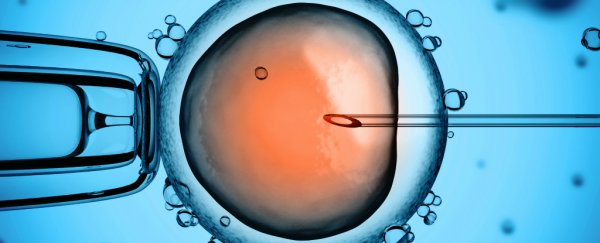Researchers in Portland, Oregon have, for the first time, edited a human embryo in the US.
This work adds to the promise of CRISPR, and it stands as an important step toward the birth of the first genetically modified humans.
By now, most of us know what CRISPR gene editing is. At the very least, we have heard of this revolutionary technology that allows us to alter DNA - the source code of life itself.
One day, CRISPR could allow us to delete genes in order to eradicate genetic diseases, add in new genes in order to vastly improve various biological functions, or even genetically modify human embryos in order to create an entirely new class of humans… of super humans.
But first, we have a lot of research to do.
And that brings us to today. Reports from MIT were just released which assert that the very first attempt at creating genetically modified human embryos in the United States has been carried out by a team of researchers in Portland, Oregon.

"So far as I know this will be the first study reported in the US," Jun Wu, who played a role in the project and is a collaborator at the Salk Institute, said to MIT.
According to MIT, the work was led by Shoukhrat Mitalipov, who comes from the Oregon Health and Science University.
Although details are scarce at this point, sources familiar with the work assert that the research involved changing the DNA of one-cell embryos using CRISPR gene-editing.
Further, Mitalipov is believed to have broken records in two notable ways:
- He broke the record on the number of embryos experimented upon.
- He is the first researcher to ever conclusively demonstrate that it is possible to safely and efficiently correct defective genes that cause inherited diseases.
This is notable because, despite the fact that it has been around for several years now, CRISPR is still an incredibly new tool - one that could have unintended consequences.
As previous work published in the journal Nature Methods revealed, CRISPR-Cas9 could lead to unintended mutations in a genome.
However, the work was later reviewed by researchers at another institution and the findings were brought into question.
It remains to be seen whether the original study will be corrected or retracted, but this development highlights the importance of peer review in science.
In this regard, Mitalipov's work brings us further down the path to understanding exactly how CRISPR works in humans, and reveals that is it possible to avoid both mosaicism (changes that are taken up not by only some of the cells of an embryo, as opposed to all of them) and ;off-target' effects.
It is important to note that none of the embryos were allowed to develop for more than a few days, and that the team never had any intention of implanting them into a womb.
However, it seems that this is largely due to ongoing regulatory issues, as opposed to issues with the technology itself.
In the United States, all efforts to turn edited embryos into a baby - to bring the embryo to full term - have been blocked by Congress, which added language to the Department of Health and Human Services funding bill that forbids it from approving any such clinical trials.
Yet, the potential of the CRISPR-Cas9 system as a gene editing technology is undeniable. As previously mentioned, it has seen success in developing possible cancer treatments, in making animals disease-resistant, and it has even shown promise in replacing antibiotics altogether.
This new work adds to the promise of CRISPR, and stands as an important step toward the birth of the first genetically modified humans.
This article was originally published by Futurism. Read the original article.
